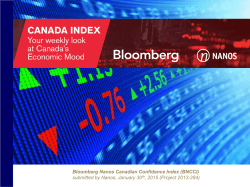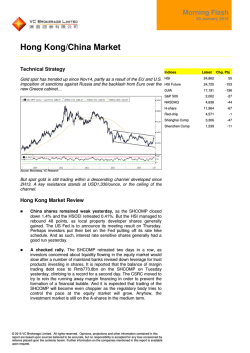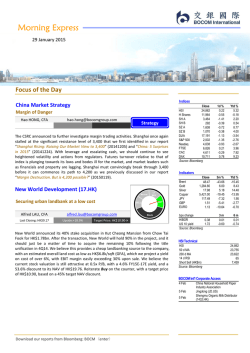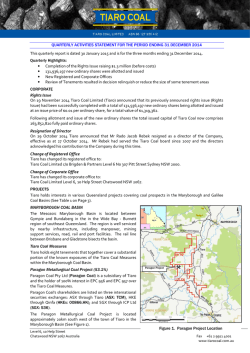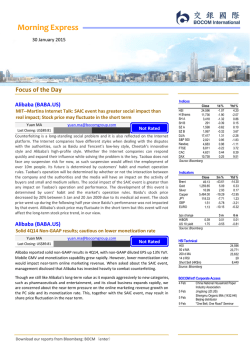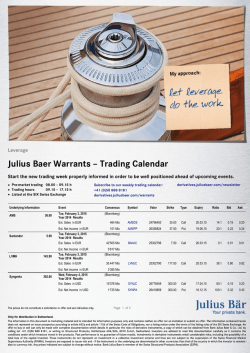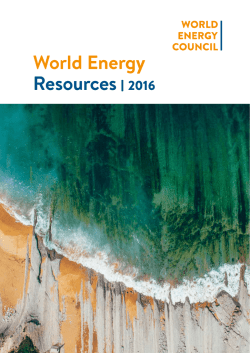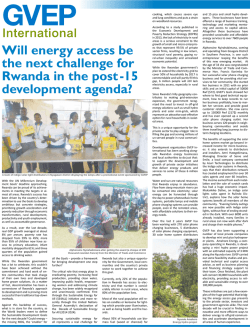
Bloomberg Presentation (PDF)
January 2015
THE COST LANDSCAPE
OF SOLAR AND WIND
Americas Insight
Nicholas Culver
AGENDA
PREFACE: RENEWABLES IN CONTEXT
SOLAR
WIND
ROUND UP
1
US CLEAN ENERGY INVESTMENT – TOTAL NEW
INVESTMENT, ALL ASSET CLASSES ($BN)
70
$65.2
60
$52.4
$48.0
50
$41.3
40
$34.6
$51.8
$48.1
$43.8
$35.4
30
$16.7
20
$10.3
10
0
2004 2005 2006 2007 2008 2009 2010 2011 2012 2013 2014
●
●
Clean energy investment in the US since 2007 has been $386bn
Investment in 2014 rebounded by 7% from 2013 levels, and is 5x higher than a decade ago
Source: Bloomberg New Energy Finance
Notes: Shows total clean energy investment in the US across all asset classes (asset finance, public markets, venture capital / private equity) as well as corporate and government R&D, and small
distributed capacity (rooftop PV). The definition of ‘clean energy’ used here is: renewable energy, energy smart technologies (digital energy, energy storage, electrified transportation), and other low-carbon
technologies and activities (carbon markets value chain, companies providing services to the clean energy industry). Values in both charts include estimates for undisclosed deals and are adjusted to
account for re-invested equity. Values are in nominal dollars.
2
US POWER OVERVIEW: RENEWABLE ENERGY
CAPACITY BUILD BY TECHNOLOGY (GW)
20
18.1
18
16
3.3
Hydro
14
12.2
11.6
12
10
10.0
0.4
5.8
6
2
9.0
0.3
8
4
Geothermal
9.2
10.5
2.0
6.5
7.2
14.0
Biomass, biogas,
waste
Solar
0.9
6.6
4.5
4.9
Wind
4.7
0.5
2008 2009 2010 2011 2012 2013 2014
●
●
●
●
Wind and solar both saw increased levels of build in 2014, relative to 2013 levels, but for different reasons:
Solar build increased by 40%. The utility-scale side of the industry brought online projects that have been driven by state
renewable energy mandates and by the long-standing federal Investment Tax Credit (ITC). (The ITC is due to drop in value at
the end of 2016.) The small-scale side capitalized on economics that increasingly make solar an attractive alternative to retail
rates in much of the US
Wind build bounced back due to policy swings. The Production Tax Credit expired at the end of 2012, dampening build in
2013. The incentive was renewed at the beginning of 2013, and it took the industry a year to reconstruct pipelines and bring
projects to completion, hence the uptick in 2014. The pipelines show strong years in 2015-16.
Other sectors – biomass, biogas, waste-to-energy, geothermal, hydro – are languishing without long-term policy certainty
Source: Bloomberg New Energy Finance, EIA
Notes: Numbers include utility-scale (>1MW) projects of all types, rooftop solar, and small- and medium-sized wind.
3
US POWER OVERVIEW: CUMULATIVE RENEWABLE
ENERGY CAPACITY BY TECHNOLOGY
US cumulative renewable capacity by technology
(including hydropower) (GW)
186
200
150
141
41
153
53
160
59
193
120
205
103
168
67
US cumulative non-hydropower renewable
capacity by technology (GW)
100
85
91
103
Other
renewables
101
101
101
101
101
101
67
41
40
3.1
11.1
1.2
20
2008 2009 2010 2011 2012 2013 2014
59
3.3
3.3
12.0
11.8
11.5 2.8
1.9
4.9
53
60
Hydropower
100
3.4
80
100
50
91
85
3.2
36.1 40.7
3.5
13.0
12.3
8.1
3.5
13.0
20.3
13.0
Geothermal
Biomass, biogas,
waste
Solar
61.2 61.7 66.4
47.2
Wind
25.8
2008 2009 2010 2011 2012 2013 2014
●
●
Power-generating capacity of non-hydropower renewables surpassed hydropower capacity for the first time
US non-hydropower renewable capacity has increased by 2.5x since 2008, mostly due to new wind and solar
Source: Bloomberg New Energy Finance, EIA
Notes: Hydropower capacity includes pumped hydropower storage facilities.
4
US POWER OVERVIEW: ELECTRICITY GENERATION
MIX
US electricity generation by fuel type (%)
22% 22%
24% 24%
25%
31% 28% 27%
19.4%19.6%
20.2%19.6%
19.3%
19.0%19.4%19.4%
Renewables
(including hydro)
4,000
Natural gas
3,000
Nuclear
2,000
Nuclear
Oil
Coal
2014
2013
2012
0
2011
2014
2013
2012
2011
2010
2009
Oil
500
37% 39% 39%
Coal
2008
1,000
2010
49% 48% 44% 45%
42%
2007
●
Renewables
(including hydro)
Natural gas
1,500
0%
●
3,500
2,500
40%
20%
CHP
2009
60%
9% 10% 10% 12% 12% 13% 13%
2008
80%
4,500
8%
2007
100%
US electricity generation by fuel type (TWh)
The US electricity mix in 2014 was nearly identical to 2013 levels. Natural gas’s contribution is off of the record high achieved
in 2012, when the fuel’s prices sank to historic lows. This up-and-down in natural gas’s market share is a cyclical effect
Longer term, though, larger structural trends are afoot: the US power sector is gradually decarbonizing. Coal plants are being
retired, and natural gas and renewables are gaining ground: from 2007 to 2014, natural gas increased from 22% to 27% of
the mix, and renewables climbed from 8% to 13%
Source: EIA
Notes: Values for 2014 are projected, accounting for seasonality, based on latest monthly values from EIA (data available through September 2013). In chart at left, contribution from ‘Other’ is not shown;
the amount is minimal and consists of miscellaneous technologies including hydrogen and non-renewable waste. In chart at right, contribution from CHP is indicated by a shaded bar in each of the columns.
The hydropower portion of ‘Renewables’ includes negative generation from pumped storage.
5
POLICY: US COAL POWER PLANT RETIREMENTS
COMPLETED AND ANNOUNCED BY YEAR (GW)
13
14
12
11
10
8
6
5
4
3
3
2
2
2
1
1
1970
1993
1994
1995
1996
1999
2000
2001
2002
2003
2004
2005
2006
2007
2008
2009
2010
2011
2012
2013
2014
2015
2016
2017
2018
2019
2020
2021
0
Retired
●
●
●
Announced
US Environmental Protection Agency (EPA) regulations covering sulfur, nitrogen, and mercury emissions from power plants
will require coal units to install costly retrofit technologies. With low gas prices cutting at the margins of coal generators, many
units are being forced to retire rather than install emissions controls
The majority of announced retirements are for 2015, when the Mercury and Air Toxics Standard (MATS), which limits the
emissions of mercury and acid gases from power generators, takes effect
Many of the boilers retiring represent the oldest and least efficient coal units in the power stack
Source: Bloomberg New Energy Finance
6
ECONOMICS: COST OF GENERATING
ELECTRICITY IN THE US FROM NATURAL GAS VS
COAL ($/MWH)
50
Gas
(CCGT)
40
30
Coal
20
10
0
Apr 2010
●
●
●
Apr 2011
Apr 2012
Apr 2013
Apr 2014
Power has served as the swing demand source for natural gas: when prices fall too low, gas burn rises until the differential (in
$/MWh) between the two fuels closes.
In 2014, the cold winter drove gas prices to regional highs, giving coal a comparative advantage across the US
The differential was particularly high in the northeast, where pipeline constraints resulted in especially high winter prices
Source: Bloomberg New Energy Finance
Notes: Assumes heat rates of 7,410Btu/kWh for CCGT and 10,360Btu/kWh for coal (both are fleet-wide generation-weighted medians); variable O&M of $3.15/MWh for CCGT and $4.25/MWh for coal.
7
HENRY HUB PRICE FORECAST ($/MMBTU NOMINAL)
12
Back to Black ($90 oil,
high LNG exports)
10
8
6
Lean Times ($70 oil,
lower LNG exports)
4
2
0
2011
●
Actual
2013
2015
2017
2019
2021
2023
2025
2027
2029
Natural gas prices are historically cheap and there appears to be about a decade of cheap gas available. Gas prices
fluctuated between $6 and $14 per Mmbtu during 2004-2008.
Source: Bloomberg New Energy Finance
8
ECONOMICS: LCOE COMPARISON FOR US
NATURAL GAS VS. COAL ($/MWH) AS A FUNCTION
OF FUEL PRICE ($/MMBTU)
LCOE ($/MWh)
70
60
50
Eastern coal LCOE
Western coal
LCOE
Gas LCOE
40
$1.15/MMBtu = $20/ton
PRB (delivered)
30
20
$2.40/MMBtu = $60/ton
Appalachian
10
0
1
2
3
4
5
6
7
Fuel price ($/MMBtu)
●
●
●
●
With gas prices below $4.50/MMBtu, new natural gas plants have a lower levelised cost of electricity than new coal power
plants anywhere in the country
The EPA’s New Source Performance Standards for carbon indicates that no new coal units could be built without carbon
capture and sequestration (CCS); that technology would push coal LCOEs even higher
At 2014 prices, economics favored new natural gas plants new coal plants (even without accounting for CCS)
With futures prices suggesting gas may rise above $5/MMBtu, LCOEs for natural gas and non-CCS coal will be close in value
Source: Bloomberg New Energy Finance
Notes: Assumes heat rates of 7,410Btu/kWh for CCGT and 10,360Btu/kWh for coal (both are fleet-wide generation-weighted medians); variable O&M of $3.15/MWh for CCGT and $4.25/MWh for coal.
9
AGENDA
PREFACE: RENEWABLES IN CONTEXT
SOLAR
WIND
ROUND UP
10
DEPLOYMENT: GLOBAL PV SUPPLY AND DEMAND
Global PV module production by country (GW)
45
60
38.7
40
35
29.7
30
3.3
25
18.1
20
2.7
30.1
3.3
10
7.7
2.3
5
1.8
9.9
19.1
7.0
Other
US
Norway
2.2
Germany
2.3
15
2.7
21.3
26.9
2009 2010 2011 2012 2013
●
40
30
20
10
China
48.7
50
Japan
3.1
●
Global PV demand by country (GW)
28.3
30.7
40.3 9.7
5.0
3.3 5.4
5.4 6.3
4.7
11.1
7.1
4.4
18.2 7.9 3.6
7.6
7.5
7.7
5.8
7.2 5.1 3.3
12.9 13.5
3.8
3.6
2009 2010 2011 2012 2013 2014
Rest of world
Italy
Germany
Rest of EU
US
Japan
China
Bolstered by strong uptake in China and Japan, PV demand rose strongly, as the global market again reduced its reliance on
European demand centers
Trade disputes raged on, as the US took steps to applying tariffs on Chinese and Taiwanese solar products (which still
account for much of the market). The US tariff regime to date has increased modules prices by roughly ~$0.15, but so far lowcost Chinese producers have largely held onto market share in the US by accepting slimmer margins
Source: Bloomberg New Energy Finance
Notes: In chart at right, 2014 values represent an average of optimistic and conservative analyst estimates.
11
ECONOMICS: PRICE OF SOLAR MODULES AND
EXPERIENCE CURVE ($/W AS FUNCTION OF
GLOBAL CUMULATIVE CAPACITY)
Cost ($/W) 100
(in 2013
dollars)
1976
1985
10
2003
2006
1
2012
2013
Q4
2013
2012
10,000
100,000
0.1
1
10
100
1,000
Experience curve (c-Si)
Module prices (Maycock)
Module prices (Chinese c-Si) (BNEF)
Experience curve (thin-film)
Module prices (thin-film) (First Solar)
●
●
1,000,000
Cumulative
capacity (MW)
Module pricing has broadly followed the experience curve for costs for the past few decades. Prices dropped in 2012 due to
manufacturing overcapacity, but then ticked back up in 2013 as oversupply began to ease
Module prices are down by more than 80% relative to 2007 levels
Source: Bloomberg New Energy Finance, Paul Maycock, company filings
Notes: Prices in 2013 USD.
12
RESIDENTIAL PV COST, ESTIMATED, (5KW
ROOFTOP) ($/W)
Equipment
Engineering, Procurement,
Construction (EPC)
Development
4.5
4.5
4.5
4.0
4.0
4.0
3.5
3.5
3.5
3.0
3.0
3.0
2.5
2.5
2.5
2.0
2.0
2.0
1.5
1.5
1.5
1.0
1.0
1.0
0.5
0.5
0.5
0.0
0.0
0.0
No.CA So.CA HI
BOS
Inverter
MA
NJ
Racking
Modules
NC
No.CA So.CA
EPC margin
EPC permitting
Labor
HI
MA
NJ
NC
General conditions
Design
No.CA So.CA
Developer fee
Interconnection
SG&A
HI
MA
NJ
NC
Developer permitting
Acquisition costs
Source: Bloomberg New Energy Finance,
13
RESIDENTIAL PV COST – SO. CALIFORNIA,
ESTIMATED HISTORICAL AND FORECAST ($/W)
7
6
Development
5
4
Engineering,
Procurement,
Construction
3
2
1
Equipment
2010
2011
2012
2013
2014
2015
2016
2017
2018
2019
2020
2021
2022
2023
2024
2025
2026
2027
2028
2029
2030
0
Source: Bloomberg New Energy Finance,
14
CALIFORNIA RESIDENTIAL PV: SUBSIDISED VERSUS
UNSUBSIDISED
100%
80%
60%
40%
20%
0%
2011
2012
No state subsidy
2013
2014
CSI-funded
Source: Bloomberg New Energy Finance,
15
UTILITY-SCALE PV COST, ESTIMATED, (10MW
GROUND-MOUNT) ($/W)
Equipment
Engineering, Procurement,
Construction (EPC)
Development
4.5
4.5
4.5
4.0
4.0
4.0
3.5
3.5
3.5
3.0
3.0
3.0
2.5
2.5
2.5
2.0
2.0
2.0
1.5
1.5
1.5
1.0
1.0
1.0
0.5
0.5
0.5
0.0
No.CA So.CA
HI
BOS
Inverter
MA
NJ
Racking
Modules
NC
0.0
No.CA So.CA
EPC margin
EPC permitting
Labor
HI
MA
NJ
NC
General conditions
Design
0.0
No.CA So.CA
Developer fee
Interconnection
HI
MA
NJ
NC
Developer permitting
SG&A
Source: Bloomberg New Energy Finance,
16
UTILITY-SCALE PV COST – NORTH CAROLINA,
ESTIMATED HISTORICAL AND FORECAST ($/W)
7
6
Development
5
4
Engineering,
Procurement,
Construction
3
2
1
Equipment
2010
2011
2012
2013
2014
2015
2016
2017
2018
2019
2020
2021
2022
2023
2024
2025
2026
2027
2028
2029
2030
0
Source: Bloomberg New Energy Finance,
17
UNITED STATES SOLAR PV FORECAST, 2010-17 (GW)
Annual
Cumulative
14
50
12
8.4
8
6.3
6.3
6
4.9
4.6
3.3
4
0
38
40
10
2
43
10.8
1.9
3.8
2.7
2.0
5.8
1.1
2.0
1.6
1.7
1.2
1.0
2.6
2.5
1.0
1.9
1.3
0.9
0.5
2010 2011 2012 2013 2014 2015 2016 2017
0.9
Residential
Nonresidential
Utility
27
30
18
20
12
10
2
4
7
0
2010 2011 2012 2013 2014 2015 2016 2017
Residential
Nonresidential
Utility
Source: Bloomberg New Energy Finance,
18
TOP US STATES, SOLAR PV GENERATION
FORECAST, 2013-17 (% OF TOTAL ELECTRICITY USE)
14%
Hawaii
12%
California
10%
Nevada
Arizona
8%
New Mexico
6%
Vermont
New Jersey
4%
Colorado
Massachusetts
2%
Utah
0%
2013
2014
2015
2016
2017
Source: Bloomberg New Energy Finance,
19
ESTIMATED COST OF SOLAR PV IN NORTH
CAROLINA, 2012-30
Capex ($/W)
Levelised cost of electricity
($/MWh)
4.00
300
3.50
250
3.00
200
Residential
2.50
2.00
150
1.50
100
1.00
0.50
Utility
Nonresidential
50
0.00
2030
2028
2026
2024
2022
2020
2018
2016
2014
2012
2030
2028
2026
2024
2022
2020
2018
2016
2014
2012
0
Source: Bloomberg New Energy Finance,
20
AGENDA
PREFACE: RENEWABLES IN CONTEXT
SOLAR
WIND
ROUND UP
21
DEPLOYMENT: US LARGE-SCALE WIND BUILD (GW)
Incremental
Cumulative
15
75
13.8
Cumulative capacity
12
60
10.4
8.5
9
45
6.6
6
4.8
4.7
4.5
2.7
3
1.7
0.3
30
15
0.8
0
0
2004 2005 2006 2007 2008 2009 2010 2011 2012 2013 2014
●
●
●
New build in 2014 rebounded six-fold from 2013 levels, from 0.8GW to 4.7GW
The increase was driven by the one-year extension of the Production Tax Credit (PTC) in 2013, the key federal incentive for
wind in the US. The PTC expired at the end of December 2012, was renewed January 2013, expired December 2013 (but
wind projects qualified for the incentive by starting construction in 2013), was ‘retroactively’ renewed in December 2014 and
expired again two weeks later, at the end of 2014. The current pipeline suggests healthy build for 2015-16
A majority of the build is occurring in Texas. The state recently completed a $7bn transmission build-out to connect windy
regions in the Panhandle and West Texas to demand centers. Wind in Texas is among the cheapest in the country, with an
unsubsidized levelized cost of electricity of around $50/MWh, due to high capacity factors (>50%) and low cost to build
Source: Bloomberg New Energy Finance
22
Hawaii
Alaska
Vermont
Massachusetts
West Virginia
Nebraska
Maine
Utah
Michigan
New York
Missouri
Wisconsin
Grand Total
Puerto Rico
California
Illinois
Montana
Pennsylvania
Washington
Minnesota
Oregon
Texas
New Hampshire
Maryland
Idaho
Arizona
Oklahoma
Indiana
New Mexico
Colorado
South Dakota
Ohio
Iowa
North Dakota
Wyoming
Kansas
COST OF WIND, SELECTED US STATES, ($/W)
4.0
3.5
3.0
2.5
2.0
1.5
1.0
0.5
0.0
Source: Bloomberg New Energy Finance
23
Alabama
Arkansas
Georgia
Kentucky
Louisiana
Mississippi
South Carolina
Tennessee
Arizona
Nevada
New Mexico
Florida
Connecticut
Massachusetts
New Hampshire
Rhode Island
Vermont
New York
Maine
Washington
Delaware
Maryland
New Jersey
North Carolina
Ohio
Pennsylvania
Virginia
Utah
Indiana
Oregon
Illinois
Colorado
Idaho
Montana
Michigan
Wisconsin
Missouri
Wyoming
California
Iowa
Kansas
Minnesota
Nebraska
North Dakota
Oklahoma
South Dakota
Texas
LEVELISED COST OF ENERGY (LCOE) OF WIND
SELECTED US STATES ($/MWH)
120
100
80
60
40
20
0
Subsidised
Unsubsidised
Source: Bloomberg New Energy Finance
24
US NEW BUILD WIND FORECAST WITH 2014 PTC
EXTENSION VS PRIOR EXPECTATIONS, 2008-2020
(GW)
13.6
Previous forecast
10.4
9.4
5.3
0.7
0.7
2.3
2013
2014
2012
2011
2010
2009
4.5
Total
Announced / planning begun
Financing secured / under construction
4.6
6.2
1.0
4.2
4.3
3.6
3.3
4.3
3.7
3.3
2.5
2017
4.0
1.6
5.0
2016
4.5
6.6
2008
2.3
2020
13.6
2015
9.1
10.4
2.5
9.1
2019
6.6
9.7
2018
9.1
Yet to be announced
Permitted
Note: Grey numbers represent our previous forecast, available here. Specifically, they correspond to a forecast based on
a scenario that assumes no PTC extension.
Source: Bloomberg New Energy Finance
25
AGENDA
PREFACE: RENEWABLES IN CONTEXT
SOLAR
WIND
ROUND UP
26
COPYRIGHT AND DISCLAIMER
This publication is the copyright of Bloomberg New Energy Finance. No portion of this document may be photocopied,
reproduced, scanned into an electronic system or transmitted, forwarded or distributed in any way without prior consent of
Bloomberg New Energy Finance.
The information contained in this publication is derived from carefully selected sources we believe are reasonable. We do
not guarantee its accuracy or completeness and nothing in this document shall be construed to be a representation of such
a guarantee. Any opinions expressed reflect the current judgment of the author of the relevant article or features, and does
not necessarily reflect the opinion of Bloomberg New Energy Finance, Bloomberg Finance L.P., Bloomberg L.P. or any of
their affiliates ("Bloomberg"). The opinions presented are subject to change without notice. Bloomberg accepts no
responsibility for any liability arising from use of this document or its contents. Nothing herein shall constitute or be
construed as an offering of financial instruments, or as investment advice or recommendations by Bloomberg of an
investment strategy or whether or not to "buy," "sell" or "hold" an investment.
27
MARKETS
Renewable Energy
Energy Smart Technologies
Advanced Transport
Gas
Carbon and RECs
SERVICES
Americas Service
Asia Pacific Service
EMEA Service
Applied Research
Events and Workshops
Nicholas Culver
[email protected]
Unique analysis, tools and data for decision-makers
driving change in the energy system
[email protected]
© Copyright 2026
